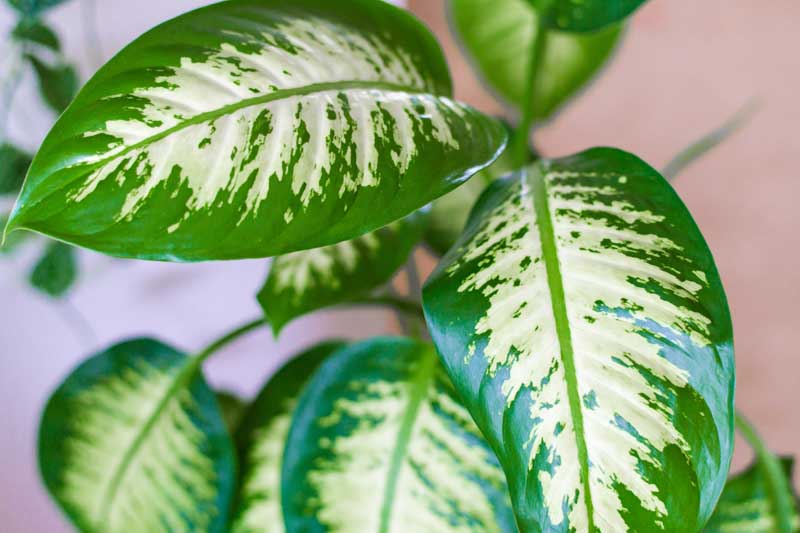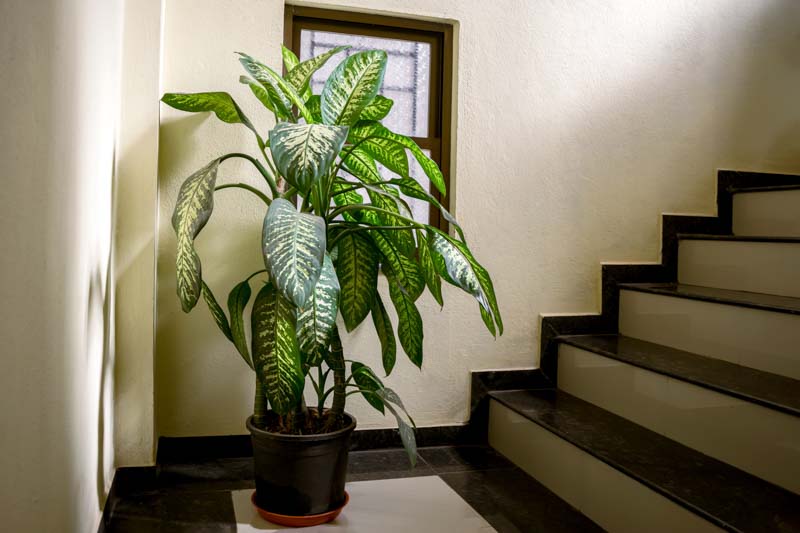Dieffenbachia, also known as Dumb Cane, is a favorite among indoor plants for its stunning foliage and easy care, making it a perfect addition to any home or office.
Dieffenbachia, commonly known as Dumb Cane, is a popular houseplant cherished for its striking, patterned foliage. This tropical plant includes several species and varieties, each with unique leaf patterns and colors. Dieffenbachia’s leaves are large, broad, and often variegated with a mix of green, white, and sometimes yellow, making it a favorite for adding vibrancy and texture to indoor spaces.
Native: Dieffenbachia is native to the tropical regions of Central and South America, where it thrives in the warm, humid environments of rainforests. Its natural habitat has influenced its care requirements as a houseplant, emphasizing the need for warmth, humidity, and indirect light.
Dieffenbachia belongs to the arum family (Araceae), along with Zantedeschia (Calla Lily), Caladium (Angel Wing), Monstera (Swiss Cheese Plant), or Colocasia (Elephant Ear).
Growth Habit: Dieffenbachia is an evergreen perennial that grows upright, with a stem that becomes more pronounced as the plant matures. It’s characterized by its lush, spreading foliage that can make a bold statement in any room.
Size: In an indoor setting, Dieffenbachia plants can grow to be about 3 to 6 feet tall (90-180 cm), depending on the species and care provided. Their size makes them an excellent choice for floor plants in interior design.
Flowers: Dieffenbachia produces flowers similar to those of other Araceae family members, with a spadix surrounded by a spathe. However, it rarely flowers indoors, and its blooms are not as visually striking as its foliage.
Foliage: The plant’s most notable feature is its foliage, which consists of large, glossy leaves reaching up to a foot in length. The variegated patterns, which range from speckled to marbled, add a dynamic visual element to the plant’s appearance.
Hardiness: Dieffenbachia plants are hardy in USDA zones 10-12, meaning they are not frost-tolerant. They require protection from cold drafts and thrive in temperatures between 65°F and 75°F (18-24°C).
Uses: Due to its striking appearance, Dieffenbachia is primarily used as an ornamental plant indoors. It’s suitable for brightening living spaces, offices, and other indoor areas where its light requirements can be met. It’s an efficient air purifier, capable of removing toxins from indoor air.
Toxicity: The plant is toxic if ingested, with the sap containing calcium oxalate crystals that can cause swelling and irritation of the mouth and digestive tract. It’s important to keep it away from pets and children. Dieffenbachia’s common name, Dumb Cane, derives from the plant’s toxic sap, which can cause temporary speechlessness if ingested.

Dieffenbachia, commonly known as Dumb Cane, holds a special place in the world of houseplants for several reasons that make it stand out:
Striking Foliage: The most distinctive feature of Dieffenbachia is its large, glossy leaves adorned with unique patterns and colors. The leaves can display a mix of green, white, and yellow, creating an eye-catching visual appeal that can brighten any indoor space.
Air Purification: Dieffenbachia is known for its ability to purify the air. It can remove toxins and improve indoor air quality, contributing to a healthier living environment.
Easy Care: Despite its exotic appearance, Dieffenbachia is relatively easy to care for. It thrives in a range of indoor conditions, requiring only moderate light, regular watering, and occasional feeding, making it suitable for gardeners of all skill levels.
Growth and Size: Dieffenbachia can grow quite large, making it an excellent choice for filling spaces and adding a lush, tropical feel to interiors. Its ability to grow quickly under the right conditions allows for rapid gratification for the caretaker.
Versatility in Design: Its striking appearance and varying sizes make Dieffenbachia a versatile option for interior decoration. It can be used as a standalone feature plant, grouped with other plants for a mixed display, or placed in strategic locations to enhance the aesthetic appeal of a room.
Resilience: Dieffenbachia shows a remarkable resilience to neglect. It can withstand occasional lapses in care, such as under-watering or poor light, making it an enduring companion for those less attentive to plant care.

| Hardiness |
10 - 12 |
|---|---|
| Plant Type | Houseplants, Perennials |
| Plant Family | Araceae |
| Exposure | Partial Sun |
| Season of Interest |
Spring (Early, Mid, Late) Summer (Early, Mid, Late) Fall Winter |
| Height |
3' - 6' (90cm - 180cm) |
| Spread |
2' - 3' (60cm - 90cm) |
| Maintenance | Low |
| Water Needs | Average |
| Soil Type | Loam, Sand, Chalk, Clay |
| Soil pH | Acid, Neutral, Alkaline |
| Soil Drainage | Moist but Well-Drained |
| Characteristics | Showy, Evergreen |
| Landscaping Ideas | Patio And Containers |
| Garden Styles | Mediterranean Garden |
| Hardiness |
10 - 12 |
|---|---|
| Plant Type | Houseplants, Perennials |
| Plant Family | Araceae |
| Exposure | Partial Sun |
| Season of Interest |
Spring (Early, Mid, Late) Summer (Early, Mid, Late) Fall Winter |
| Height |
3' - 6' (90cm - 180cm) |
| Spread |
2' - 3' (60cm - 90cm) |
| Maintenance | Low |
| Water Needs | Average |
| Soil Type | Loam, Sand, Chalk, Clay |
| Soil pH | Acid, Neutral, Alkaline |
| Soil Drainage | Moist but Well-Drained |
| Characteristics | Showy, Evergreen |
| Landscaping Ideas | Patio And Containers |
| Garden Styles | Mediterranean Garden |
Create a membership account to save your garden designs and to view them on any device.
Becoming a contributing member of Gardenia is easy and can be done in just a few minutes. If you provide us with your name, email address and the payment of a modest $25 annual membership fee, you will become a full member, enabling you to design and save up to 25 of your garden design ideas.
Join now and start creating your dream garden!
Create a membership account to save your garden designs and to view them on any device.
Becoming a contributing member of Gardenia is easy and can be done in just a few minutes. If you provide us with your name, email address and the payment of a modest $25 annual membership fee, you will become a full member, enabling you to design and save up to 25 of your garden design ideas.
Join now and start creating your dream garden!